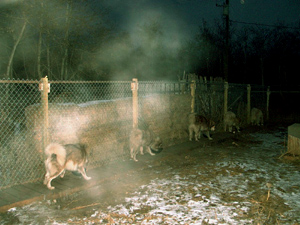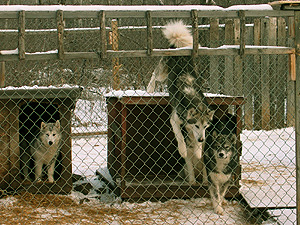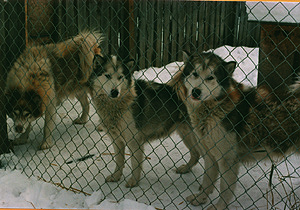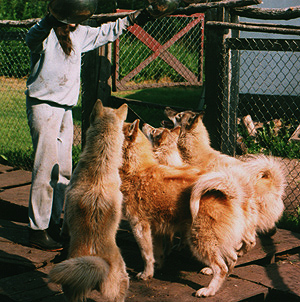Table of Contents
*
F.I.D.O.: Ken Beattie
*
Nunavik Dog Slaughters, Part II
*
Fan Mail
*
In the News
*
Behavior Notebook: Life in the Pack
*
Book Review: Soldiers & Sled Dogs
*
Janice Howls: Preserving Nature's Standard
*
IMHO: Tough Dogs, Tough Owners
Navigating This
Site
Index of articles by subject
Index
of back issues by volume number
Search The
Fan Hitch
Articles
to download and print
Ordering
Ken MacRury's Thesis
Our
comprehensive list of resources
Talk
to The
Fan Hitch
The Fan
Hitch home page
ISDI
home page
Editor's/Publisher's Statement
Editor: Sue Hamilton
Webmaster: Mark Hamilton
The Fan Hitch welcomes your letters, stories, comments and suggestions. The editorial staff reserves the right to edit submissions used for publication.
Contents of The Fan Hitch are protected by international copyright laws. No photo, drawing or text may be reproduced in any form without written consent. Webmasters please note: written consent is necessary before linking this site to yours! Please forward requests to Sue Hamilton, 55 Town Line Rd., Harwinton, Connecticut 06791, USA or mail@thefanhitch.org.
This site is dedicated to the Inuit Dog as well as related Inuit culture and traditions. It is also home to The Fan Hitch, Journal of the Inuit Sled Dog.

The Balladin
pack
photo:
Montcombroux
Life in the Pack
by Geneviève Montcombroux
When we moved to the Interlake region of Manitoba with the intention to breed our Inuit Sled Dogs, the idea was to recreate as much as possible their native environment. We felt that the seven-month long winter would compensate for the heat of summer.
In the past, when Inuit were nomadic, their dogs used to roam free in the camps. We couldn't have them run free so the next best thing was large pens. The pens are close to the house and I can see each of them from the windows, an excellent observation post.
Since we couldn't get seal to feed the dogs, I consulted the Winnipeg Zoo nutritionist, and we came up with a meat-based diet which includes muscle and organ meat, fat, rice - the ISD like the wild canidae does not assimilate most other grains - and a zinc, vitamin B complex, salt and calcium supplement.
Our adult dogs reach the optimum sizes: 40-41kg(88-90lbs) for males, 26-27kg(58-60lbs) for females. Our old dogs (11 to 14) have clear eyes, hear perfectly well - when they want to - and in winter still run 3 km (2 miles) albeit slower than they used to. There has been no sign of arthritis except in a couple of dogs that had sustained a significant joint injury.
Over the years the size of our packs have fluctuated. A small pack is made up of four dogs, a big pack is seven to nine dogs with a range of ages. Six-week-old puppies meet the adult dogs of their pack on a one-to-one basis. By ten or twelve weeks, they join the pack.
Puppies are definitely at the bottom rung of the ladder. They have learned to squeal playing with each other under their mother's tolerant supervision. Now in the pack, their squealing takes new proportions. The squealing must have an effect on the adult males. I have never seen one hurting a squealing pup. My first observation of this was when I took the boss dog of their future pack, in harness, out walking with the pups and their mother. If there is another female in that pack, usually the grandmother, she too comes along for the first walk. I don't normally keep more than two females per pack, and they are always related females. Packs that are composed of family members are more cohesive than those made up with unrelated dogs.

Neviortok and
pups
photo:
Montcombroux
Invariably, the boss dog lunges toward a pup and nips him. The pup squeals. The adult male appears to be satisfied and repeats the nipping with each of the pups. The pups are not phased out and they continue running between our legs, their mother and the male. The adult female doesn't nip the pups. She sniffs their rears. They squeal. The male dog continues showing great interest in the pups and tries to sniff them too.
We introduce the pups to each male in the pack in that manner and they all behave in the same way. Then the pups spend their first day in the pen with the adults. They inspect everything. They get growled at when they jump on a sleeping dog, squeal and come back right away. Adult dogs are very tolerant of the pups.
Up to about six months two or three pups may eat out of the same bowl, play musical bowls, get food over their faces, then spend ten minutes licking each other. They go to the adults and lick their mouths in the hope of getting them to regurgitate. It always works with their mother, but only occasionally with the other adults.
Games of tag are the favorites among the pups. Their mother joins them, and soon after the rest of the adults. Pups end up by getting in somebody's way and are rolled over. The outraged squealing gets the attention of an adult or two, who will come to sniff and poke at the youngster. The game promptly resumes.

The Mousquetaires
pack
photo:
Montcombrouox
Reaching six months marks a change in behavior. Playing musical bowls leads to growling and fighting, with the grandmother jumping in to re-establish order. This causes the mother to jump on her own mother. Although she is not correcting her pups, she doesn't tolerate the other female doing so. This I have seen repeated at times other than mealtime. The boss does not interfere. From that point on, all the dogs in the pack get picketed at feeding time - always at the same picket. It also ensures that each pup eats the proper amount of food for his growth. The first time, the pups pull on the chain and cry until they get the food in front of them. On the second day they don't pull or cry. They just howl impatiently. On the third day, they run to their own picket and wait. By the time they are a year old, they don't need to be tied up anymore at mealtime. They eat from their own bowls, look at the neighbors and when bowls are empty switch to lick the last little crumb, though in a pack of seven or nine, this is not practical as too much time - in the dogs' opinion - elapses between the first and last bowl. The caregiver only has two arms.
Nine months seems to mark another change in behavior. Now the mother begins correcting her pups. It is really funny because they are as big as she is. She is also ruthless in her punishment, though she still objects to the grandmother's correcting the pups. Now, the boss jumps into the pups' squabbles with a loud growl and a hard shove. When peace is restored, the pups come and lick the boss' mouth. Other adult male dogs in the pack do not interfere - not unless the boss is out of the pen. The mother is the only one who grabs a pup's muzzle and bites hard. Not hard enough to leave a mark, but seriously enough to make the young dog cry pitifully.
There is a lot of open mouth greeting at any time. If a dog comes from the back of the pen and join a couple of dogs at the front, they touch noses. With open mouths, they feel each other's muzzles. The younger dogs also often lift a front paw to touch an older dog.
Right from the beginning, there will be a pup who kowtows to the boss. He is frequently at his side, touching, mouth licking and greeting. The boss accepts all the attention gracefully.
As pups grow, one, two, three years, they still play catch-me-if-you-can games, but now grandmother often contemplates the youths from the roof of her house. Occasionally, a fight breaks out which the boss squelches rapidly. Although some ears have been torn and required stitching, veterinary assistance is not necessary.

Free feeding
time!
photo:
Montcombroux
However, at a time when we had rescued dogs and didn't have enough large pens, I noticed a higher incidence of fighting - dirty fighting too, with puncture wounds and slashed faces being the most frequent.
There comes a time when the boss no longer has the same speed and strength. That's when he is challenged by a younger male. When he loses, and depending on the individual, he accepts defeat remaining in the pack but not taking part in its general life. A defeated boss dog doesn't live long when he remains in his pack. I prefer to take him and the oldest female to live in comfort in a smaller pen. Currently we have four old couples, eleven to thirteen years.
There is one more observation I have to report. If you don't like being grossed out, stop reading now. Pups eat warm feces. Like they did in ancestral arctic times, they run up to the defecating adult and catch the matter before it hits the ground. They have their favorite too, their parents' feces being the most sought after. They continue vying for this delicacy into adulthood, sometimes until four or five years of age.
Right from puppyhood, dogs are keen observers of the adult behavior and copy it. This lead me to remove a male with a detestable attitude from the pack so that the pups wouldn't copy him. He now lives with his grandmother, and with much individual attention, has abandoned his obnoxious behavior. But he won't return to the pack. Once a dog has been removed for a length of time, it is almost impossible to re-integrate him. The harmony has been destroyed.
That's life in a pack.